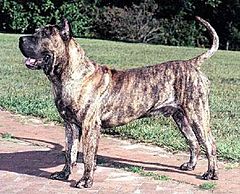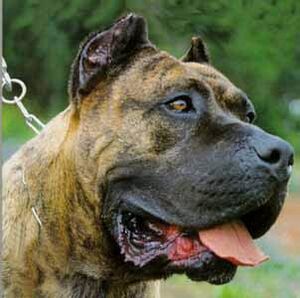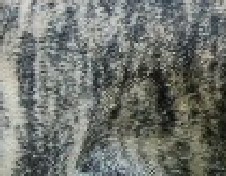Perro de Presa Canario facts for kids

Perro de Presa Canario
|
||||||||||||||||||
| Other names | Canary Mastiff Canary Catch Dog Canarian Molosser Presa Canario Dogo Canario |
|||||||||||||||||
|---|---|---|---|---|---|---|---|---|---|---|---|---|---|---|---|---|---|---|
| Common nicknames | Presa | |||||||||||||||||
| Origin | Canary Islands (Spain) | |||||||||||||||||
|
||||||||||||||||||
| Notes | The breed is recognized, by the FCI, on a definitive basis and eligible for the CACIB from 6 July 2011. | |||||||||||||||||
| Domestic dog (Canis lupus familiaris) | ||||||||||||||||||
The Perro de Presa Canario, also known as the Canary Mastiff, is a large and strong dog breed. It comes from the Canary Islands in Spain. People originally bred these dogs to help with farm animals.
The name "Perro de Presa Canario" is Spanish. It means "Canarian catch dog." People often shorten its name to "Presa Canario" or just "Presa." Sometimes, it is also called "Dogo Canario," which means "Canarian Molosser." This dog is a special symbol of the island of Gran Canaria.
Contents
Appearance of the Presa Canario
The Perro de Presa Canario is a big dog with a strong, muscular body. Its head is wide, large, and square-shaped. This strong head and its expression are important parts of what makes the breed special.
Sometimes, their ears are cropped. This means they are made to stand up. This was done to make the dog look more powerful and to protect its ears when working with cattle. In places where ear cropping is not allowed, their ears hang down close to their head.
The upper lip of the Presa Canario hangs down a bit. When you look at the dog from the front, its upper and lower lips meet to form an upside-down V shape. The inside of their lips is usually a dark color.
Size and Weight
Male Presa Canarios are usually about 23 to 26 inches (58 to 66 cm) tall at the shoulder. They weigh at least 100 pounds (45 kg) and can weigh up to 160 pounds (73 kg).
Female Presa Canarios are a bit smaller. They are usually between 22 to 25 inches (56 to 64 cm) tall. They weigh at least 85 pounds (39 kg) and can weigh up to 70 kilograms (150 lb).
Body Shape and Movement
This breed has a back that slopes slightly downwards from the rear to the shoulders. Their paws are shaped like a cat's foot. They also move in a way that is often described as cat-like. Their body is a bit longer than they are tall. This body shape helps them move smoothly, like a cat.
History of the Presa Canario
Historians say that large dogs have been on the Canary Islands for a very long time. These dogs were important to the native people, called the Guanches. They were part of their myths and even their food.
For example, the Guanches believed that demons sometimes looked like big, furry dogs. These were called "Tibicenas" on Gran Canaria and "Irnene" on La Palma. Dogs were also sometimes mummified and buried with their owners. This was because people believed dogs could guide them to the afterlife.
After the islands were conquered, these large, strong dogs continued to be important. Records from the 1500s show that people were allowed to own "one of the largest" dogs.
These dogs were often used to protect farm animals from wild dogs. Sometimes, people were even paid for killing wild dogs if they showed the wild dog's head. At other times, many of these dogs were ordered to be killed because they caused damage to farm animals. There were rules about keeping them tied up. Also, only farmers or hunters were allowed to own them at certain times. These rules were in place between the 1500s and 1700s.
Besides helping with cattle, Perros de Presa Canario were also used in dog contests. This was a common activity on the islands until the 1950s.
Coat and Color
The Presa Canario has a short coat. It feels a bit rough and does not have a soft undercoat. Their fur comes in many shades of fawn and brindle. Brindle means they have stripes of different colors. This breed is known for not shedding much hair.
Temperament of the Presa Canario
Presa Canarios need to be socialized early. This means they need to meet many different people, places, and other animals when they are young. They also need obedience training from a young age.
Sometimes, these dogs can be aggressive towards other dogs. They might also be wary of strangers. Because of their size, this breed has sometimes been used in dog sports.
Lifespan of the Presa Canario
A Perro de Presa Canario usually lives for about eight to 12 years.
Rules for Owning a Presa Canario
Some countries have rules about owning this breed. For example, it is not allowed to bring or sell Presa Canarios in Australia and New Zealand.
Images for kids
See also
 In Spanish: Presa canario para niños
In Spanish: Presa canario para niños












